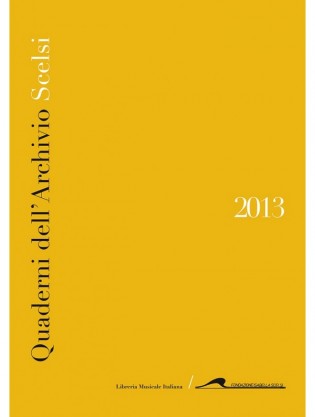 View larger
View larger
Rotativa e dintorni. Uno sguardo al primo Scelsi
Online only
| Author | Alessandra Carlotta Pellegrini |
| Editor | Mario Baroni e Alessandra Carlotta Pellegrini |
| Series | Quaderni dell’Archivio Scelsi |
| Nr. | 1 |
| Size | 17×24, pp.159 |
| Year | 2013 |
| ISBN | 9788870967517 |
For a long time, Giacinto Scelsi has been considered essentially for the works that distinguished his later years, from the second half of the 1950s onward. A renewed and more attentive focus on behalf of musicological researchers has recently shone a light on Scelsi’s early production, dated back to the mid forties.
This approach stems from the awareness of the fact that Scelsi developed his personal musical and spiritual dimension only after confronting himself with the most diverse cultural and musical dimensions of his own time, after testing their potential and resources and not finding them suitable for himself and his creative needs.
A more appropriate and in-depth investigation on some of the core-themes of Scelsi’s work aims to trace a detailed outline of his artistic personality and unique style, through the four different parts that form this essay.
First and foremost, the essay opening deals with the study of the stimuli that were most assimilated by historical avant-garde movements, especially those related to the parisian and musical environment of the time, in the light of some of Scelsi’s writings of uttermost importance (Sens de la musique, Evolution de l’harmonie and Evolution du rythme). Facing a very limited amount of information concerning Giacinto Scelsi’s training, the consistency of his writings helps us make up for the lack of resources regarding his studies and musical apprenticeship.
The essay then focuses on the formative experiences that the composer encountered during his youth travels (between the late Twenties and the early Thirties, Egypt, Paris, Vienna, Geneva), with the precious support of his autobiography Il sogno 101 in which many pages are dedicated to the description of the multiple cultural and artistic inspirations that Scelsi met during those traveling years.
The third part illustrates Scelsi’s relationships with his teachers, the one with Giacinto Sallustio in particular, up to the creation of Rotativa, the composition that lead Scelsi to his official debut on the International Music scene.
At the end of the essay, we pause to analyze the five different existing versions of this work: for one piano, for two pianos, for two pianos and thirteen percussions, for orchestra (with strings), for orchestra (without strings). The two orchestra versions were discovered only recently in the course of a research conducted in the archives of the Maestro.
The different versions of Rotativa clearly state that for Scelsi this work was his debut piece and not a simple exercise: Scelsi assimilates and metabolizes the cultural and musical experiences of the twenties; and by doing so he explicitly points out his teachers and role models. Nevertheless, already in these early years, Scelsi presents himself to us as an individual, revealing a distinct position that is that of a completely independent and unconventional artist.

